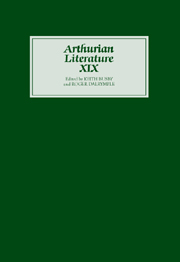Book contents
- Frontmatter
- Contents
- General Editor's Foreword
- I Comedy and Tragedy in Some Arthurian Recognition Scenes
- II Merveilleux et comique dans les romans arthuriens français (XIIe–XVe siècles)
- III La bande dessinée virtuelle du lion d'Yvain: sur le sens de l'humour de Chrétien de Troyes
- IV Convention, Comedy and the Form of La Vengeance Raguidel
- V Le comique dans Les Merveilles de Rigomer et Hunbaut
- VI Humour in the Roman de Silence
- VII La pratique de la ‘disconvenance’ comique dans le Lancelot en prose: les mésaventures amoureuses de Guerrehet
- VIII Lancelot Part 3
- IX Comic Functions of the Parrot as Minstrel in Le Chevalier du Papegau
- X Dinadan en Italie
- XI A Comical Villain: Arthur's Seneschal in a Section of the Middle Dutch Lancelot Compilation
- XII Malory and the English Comic Tradition
- XIII ‘Laughyng and Smylyng’: Comic Modalities in Malory's Tale of Sir Launcelot du Lake
- XIV The Eachtra an Amadáin Mhóir as a Response to the Perceval of Chrétien de Troyes
- CONTENTS OF PREVIOUS VOLUMES
XIII - ‘Laughyng and Smylyng’: Comic Modalities in Malory's Tale of Sir Launcelot du Lake
Published online by Cambridge University Press: 05 February 2013
- Frontmatter
- Contents
- General Editor's Foreword
- I Comedy and Tragedy in Some Arthurian Recognition Scenes
- II Merveilleux et comique dans les romans arthuriens français (XIIe–XVe siècles)
- III La bande dessinée virtuelle du lion d'Yvain: sur le sens de l'humour de Chrétien de Troyes
- IV Convention, Comedy and the Form of La Vengeance Raguidel
- V Le comique dans Les Merveilles de Rigomer et Hunbaut
- VI Humour in the Roman de Silence
- VII La pratique de la ‘disconvenance’ comique dans le Lancelot en prose: les mésaventures amoureuses de Guerrehet
- VIII Lancelot Part 3
- IX Comic Functions of the Parrot as Minstrel in Le Chevalier du Papegau
- X Dinadan en Italie
- XI A Comical Villain: Arthur's Seneschal in a Section of the Middle Dutch Lancelot Compilation
- XII Malory and the English Comic Tradition
- XIII ‘Laughyng and Smylyng’: Comic Modalities in Malory's Tale of Sir Launcelot du Lake
- XIV The Eachtra an Amadáin Mhóir as a Response to the Perceval of Chrétien de Troyes
- CONTENTS OF PREVIOUS VOLUMES
Summary
[T]he final tales of the Morte Darthur can be read both as the tragedy of Arthur and his knights … and as a ‘comic’ affirmation of their ‘worshipful’ lives and values.
(Larry Benson, Malory's Morte Darthur, 209)Than there was laughying and smylyng amonge them …
(Malory, Tale of Sir Launcelot, 208)Benson's reading of the Morte Darthur as Christian comedy notwithstanding, there is no question but that Malory's narrative, with its grim account of the disintegration of a once-ideal kingdom, is, in the end, a tragedy, a profoundly pessimistic commentary on the frailty of human nature. From the Book of Sir Tristram through the final explicit, light moments are few and far between; all the major figures are to be taken in dead earnest, for good or for ill. The tenor of the Morte as a whole, however, is by no means unremittingly dismal. Throughout the narrative there are flashes of optimism in human potential, of confidence that good can triumph over evil, and while these tend to concentrate in the first third of the book during the formative years of the kingdom, the thread of hope still faintly gleams in the increasingly somber tapestry of the final portions: Trystram succeeds in his quest to become a member of the Round Table fellowship, Palomydes experiences conversion, Lancelot miraculously heals Sir Urry. The Grail does prove enchevable, even if by only a precious few, and Guinevere, after all was said and done, ‘had a good ende’ (791).
- Type
- Chapter
- Information
- Arthurian Literature XIXComedy in Arthurian Literature, pp. 189 - 198Publisher: Boydell & BrewerPrint publication year: 2002



